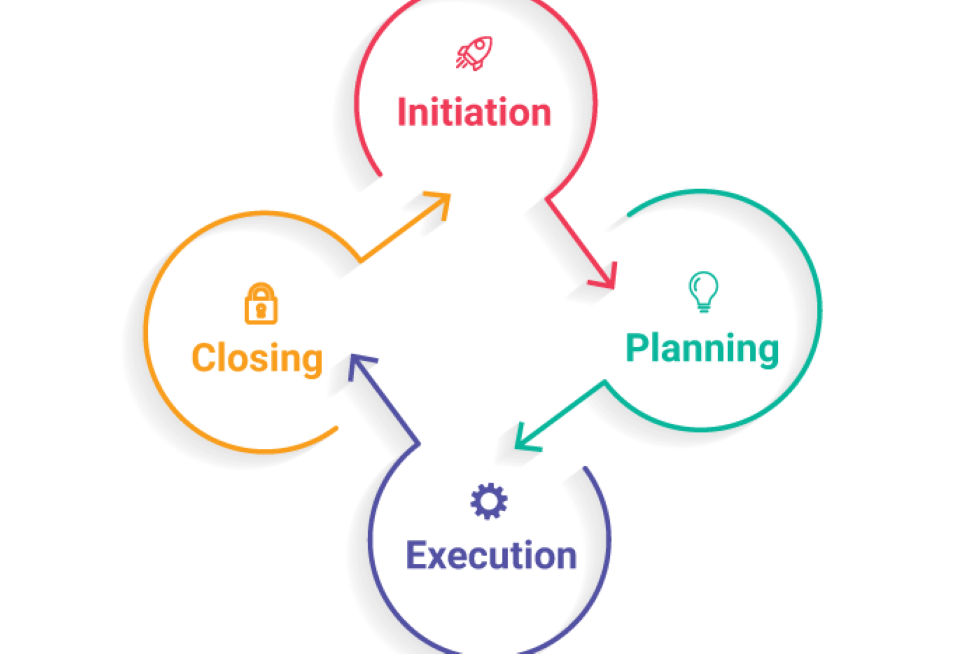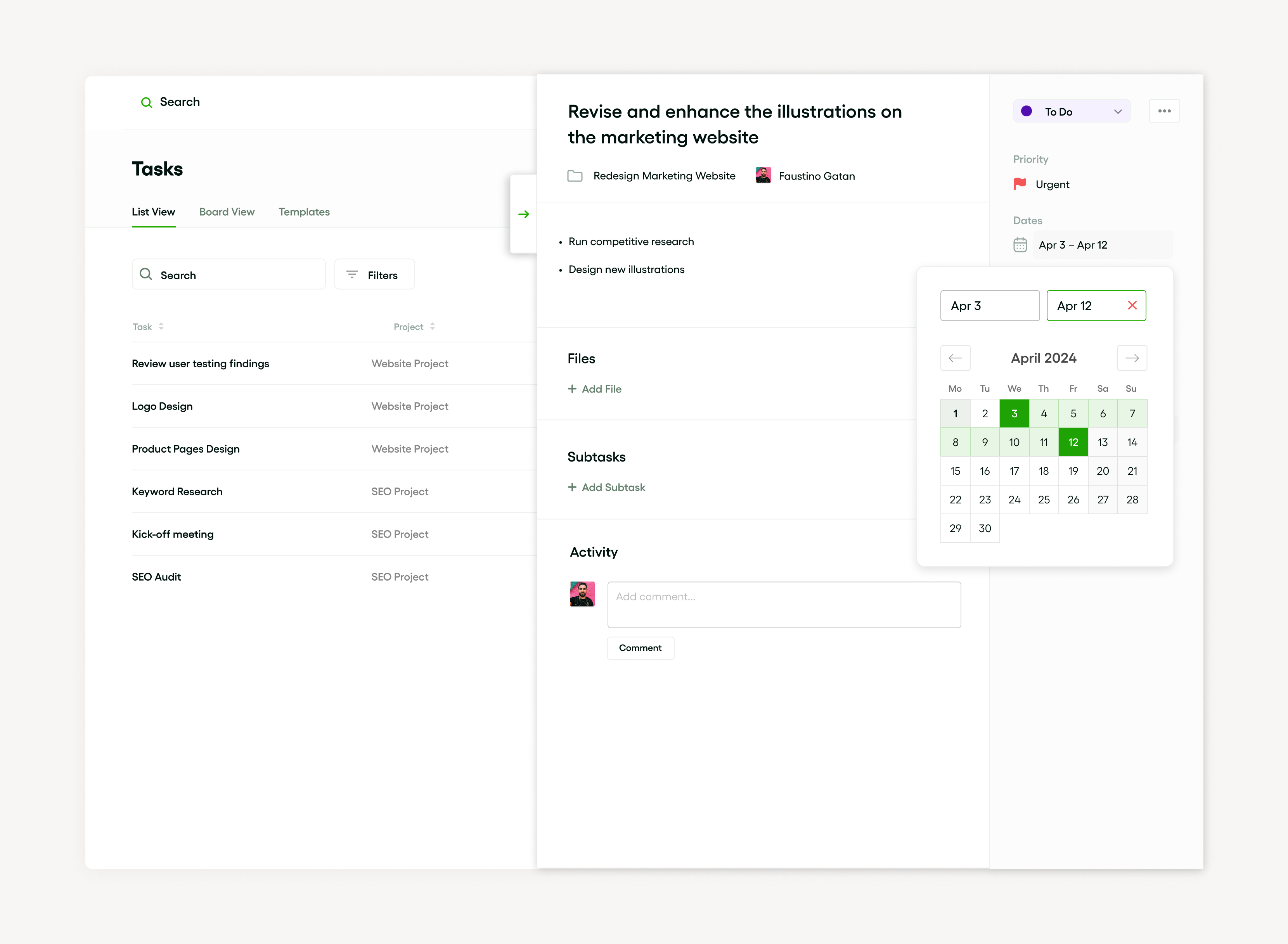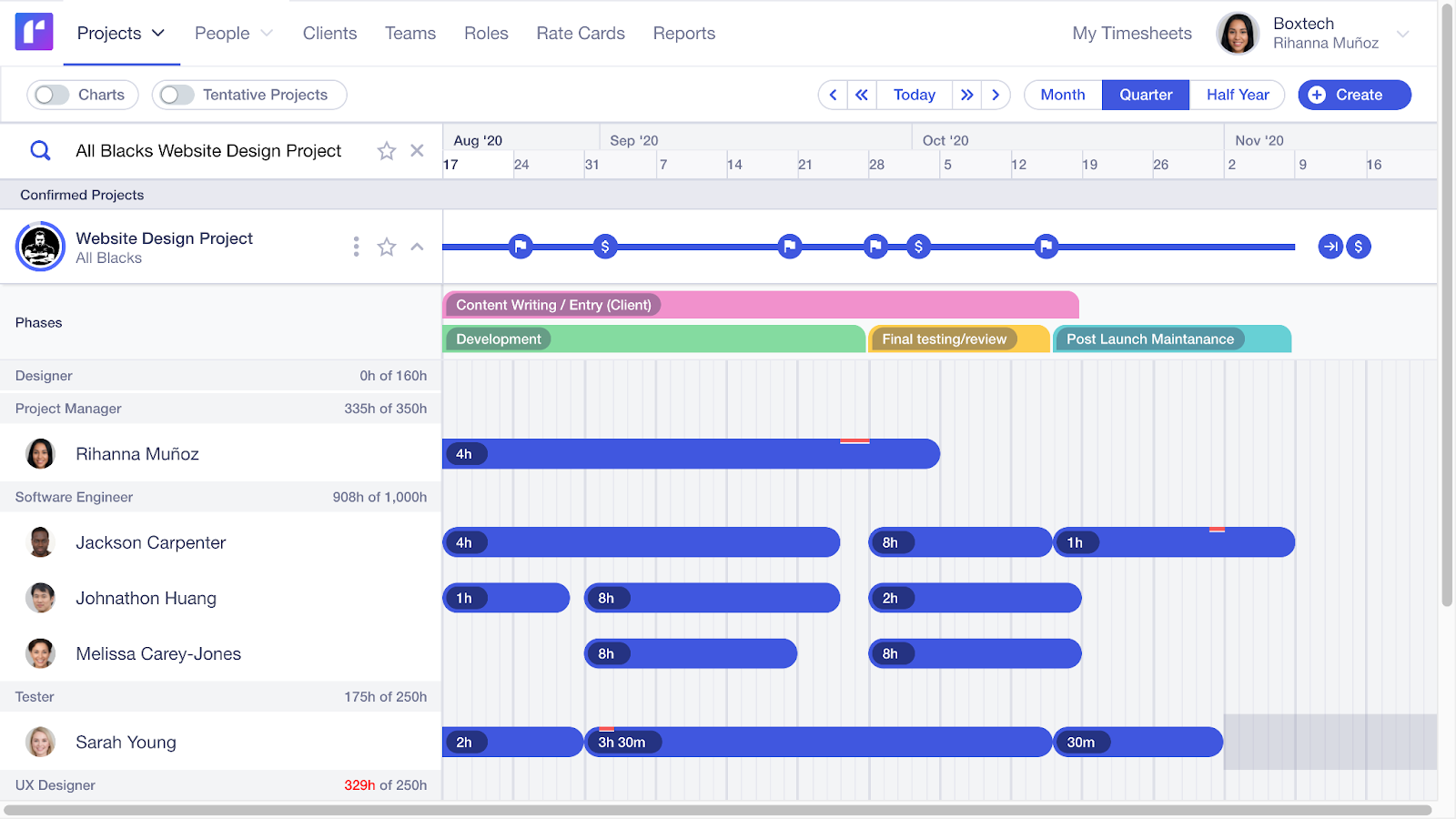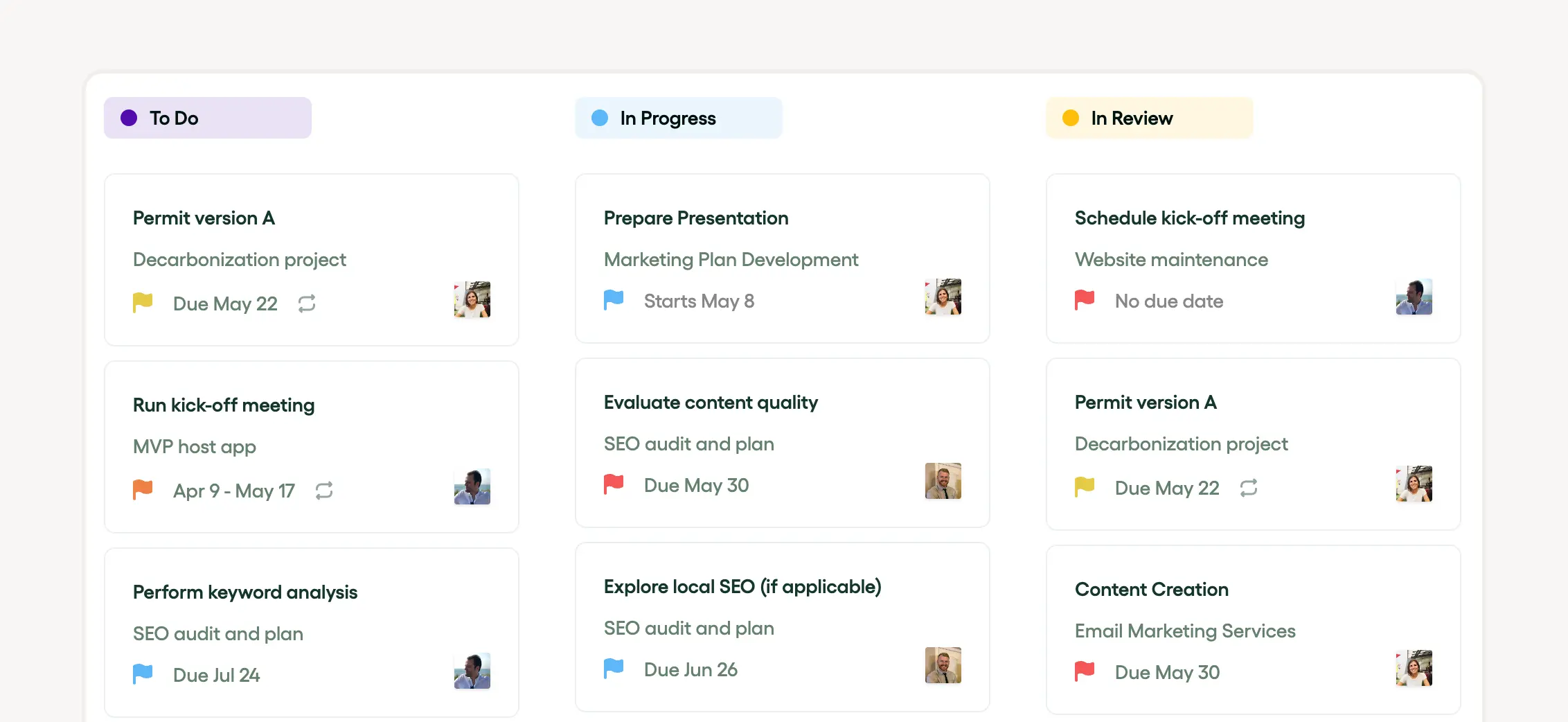Navigating a project from start to finish involves a series of crucial phases, each with its own set of tasks and objectives.
- Kick things off with the project initiation, where the blueprint starts with a solid proposal outlining the scope, goals, and risks.
- For step 2, dive into the planning phase, where every detail of the project management plan is meticulously crafted, including a thorough work breakdown structure and precise deliverables.
- And finally, the execution phase swings into full gear, bringing plans to life.
Monitoring and control form the penultimate phase, keeping the project aligned with its objectives. Finally, the project closing wraps everything up, tying up loose ends and gathering insights for future endeavors.
Introduction to project life cycle
The Project Life Cycle covers five foundational stages:
- Initiation
- Planning
- Execution
- Monitoring & control
- Closing
This cyclical journey structures the project management process, directing teams toward achieving project goals and crafting quality deliverables.
Each phase is distinct—initiation sets the groundwork with scope and proposals, planning details the pathway, execution brings the vision to life, monitoring ensures adherence to goals, and closing finalizes and reflects.

Definition of project life cycle
What exactly is a Project Life Cycle? To put it in simple terms, it outlines the sequential stages a project undergoes—from initiation to closing. This framework ensures a systematic approach to managing tasks and achieving goals. Integral to this cycle is robust documentation, which includes detailed plans and structures vital for navigating the project successfully.
Each stage plays a critical role in understanding the project’s scope, identifying risks, and ensuring the delivery of expected outcomes, ultimately enhancing the likelihood of a project’s success.
Importance of understanding the project life cycle
Grasping the Project Life Cycle is crucial for effective project management. It involves identifying key stages from initiation to closing, which helps in crafting a solid management plan. This knowledge ensures projects meet goals, stay within scope, and deliver on time.
It also supports developing a detailed structure and thorough documentation, mitigating risks, and maintaining efficient oversight of the project’s progress—underlining why understanding this cycle is pivotal for crafting a winning project strategy.
Phase 1: Project initiation
Project initiation marks the beginning of the project’s journey, setting the stage with clear goals, scope, and identification of potential risks. This phase is crucial as it lays the foundational blueprint and guides the subsequent planning and execution phases.
Key elements like the project management plan and work breakdown structure are developed here, ensuring the project is poised for smooth progression through subsequent stages.
In Bonsai, the project initiation phase is important for establishing a solid foundation for a successful project. This phase involves creating tasks to delegate responsibilities and setting clear deadlines to ensure everyone understands their roles from the beginning.

The project management plan is crafted to outline the project's scope, objectives, and deliverables, as well as resource allocation, budgeting, and risk management strategies.
Bonsai facilitates the development of a work breakdown structure (WBS), which allows you to divide the project into manageable tasks and subtasks, establish milestones, and allocate resources effectively. This methodical approach during the initiation phase helps guarantee that the project is well-structured and positioned for success.
Defining the project goals
At the core of the project initiation is defining clear, actionable goals. These goals steer the entire project through its lifecycle, ensuring every stage from planning to closing is aligned with achieving the set objectives.
How do you define these goals in the first place? Well, it all starts with a detailed plan instrumental in guiding the project, highlighting the importance of clear goal-setting from the outset.
Identifying key stakeholders
Stakeholders are integral throughout the project’s lifecycle. Their involvement starts from defining the scope and goals during initiation, extends through planning and execution, and concludes with validating the project’s success at closing. Their engagement is crucial for aligning the project with broader business objectives and ensuring comprehensive stakeholder satisfaction.
Role of project charter in project initiation
The Project Charter is a cornerstone document in project initiation. It not only defines the scope and goals but also outlines the risks and provides a roadmap for the entire project. This document guides all phases, ensuring consistent adherence to the project’s objectives and facilitating effective monitoring and control.
Phase 2: Project planning
The agency resource management plays a crucial role in accomplishing the different stages in a project life cycle, ensuring all resources are efficiently used. It comprises planning, scheduling, and allocating agency resources accurately. This practice enhances the overall effectiveness of project management.
The sprint planning meeting is a crucial part of the project life cycle; it helps the team to set clear objectives and focus on the right tasks. The outcome of each sprint will determine the project direction in terms of features to be developed or issues to be fixed. This is a continuous loop that will play a significant role in the project's overall success.
During the project life cycle, managing teams and resources effectively is vital for success. Luckily, the right tools can greatly streamline this process, such as the software solutions specifically designed for creative agencies. These can help maintain efficiency, boost team collaboration, and ensure all project goals are met within the expected timeline.
Executing a project from start to finish requires a comprehensive understanding of the various stages involved. One essential aspect to consider during the project life cycle is effective management of certain key elements which is beautifully explained in our article on the project management triple constraint. This understanding will help keep the project on track and ensure intended goals are met on time.
During the execution phase of the project life cycle, it's essential to accurately track billable hours to ensure productivity and profitability.
The project life cycle has several stages, each calling for detailed planning and oversight. To manage documents effectively during these stages, it is crucial to implement a robust document management workflow. This aids in streamlining processes, enhancing collaborative efforts, and ensuring project success.
The project planning phase is all about laying out the project goals, scope, and deliverables. You gotta use tools like the project management plan and work breakdown structure to get things organized and divide tasks.
At this stage, project initiation is the main gig, setting the roadmap for where the project’s headed and what it aims to achieve. This includes whipping up a project proposal, outlining potential risks, and defining the management process.
Once all the planning is over, the project moves to execution, then wraps up with monitoring & control, and finally, project closing. This step-by-step journey ensures all documentation is handled right.
Creating a detailed project plan
The project management process kicks off with project initiation, where you create a detailed project proposal. This proposal lays out the scope, goals, deliverables, and potential risks. It’s the foundation for developing a comprehensive project management plan.
The plan further describes the work breakdown structure, envisioning stages from initiation, planning, execution, monitoring & control, to closing. It also includes provisions for maintaining systematic documentation throughout the lifecycle.
Where should you be focusing? The focus is on hitting deliverables within the defined scope. Regular monitoring and control measures help mitigate risks and ensure successful execution and closure.
Role of Gantt charts in project planning
Gantt charts are a game-changer in project planning. They visually display the project stages and provide a clear timeline from initiation to execution and closing. These charts break down the scope into manageable deliverables, presenting each task in a work breakdown structure.
They help align project goals with the management plan, enhancing monitoring and control. Gantt charts also highlight potential risks, allowing mitigation strategies to be incorporated early on, ensuring effective documentation.
Importance of risk management in project planning
The best way to reduce risk is to plan for it, and this is where risk management comes in. Risk management helps identify, assess, and prioritize risks that might pop up during various stages like initiation, execution, and closing. Proactive risk management lets managers mitigate potential risks effectively.

A well-thought out risk management plan is part of the overall project management plan, promoting efficiency in managing goals, deliverables, and scope. The process involves thorough reviews of documentation and constant monitoring to catch unforeseen risks early.
Failing to manage risks can derail even the best-laid plans, highlighting the importance of risk management in planning.
Phase 3: Project execution
In the project execution phase, the management plan developed during initiation and planning is put into action. This phase involves carrying out tasks detailed in the work breakdown structure to achieve goals and produce deliverables.
The process also involves systematic documentation of information and decisions. Monitoring & control is crucial to ensure the project stays within the defined scope.
Risks are managed proactively during this phase to prevent derailment and ensure the project closes on schedule and within budget.
Managing resources and tasks
Managing resources and tasks is critical in the project management process. It starts with initiation, where proposals are created, specifying scope, risks, goals, and deliverables. Then comes planning, where a detailed management plan and work breakdown structure are developed.
The subsequent stages include execution, where the team works on deliverables, with constant monitoring and control to ensure alignment with the plan. Finally, closing involves a final review and comprehensive documentation.
Role of project management software like Bonsai, Trello and Asana
Project management software like Bonsai,Trello and Asana are essential for managing various stages from initiation to closing. These tools offer a structured approach, helping teams plan, execute, and monitor tasks effectively. Key features include setting goals, outlining scope, and detailing the management plan, often with a work breakdown structure.
These platforms also allow efficient tracking of deliverables, risks, and progress. By centralizing all documentation, they enhance productivity and streamline communication among team members, contributing to successful execution.
Project management software like Bonsai plays an important role in enhancing productivity and organization. It helps in setting clear goals by providing tools to define objectives and track progress. By outlining the project scope, it ensures all team members understand their roles and responsibilities.

Additionally, Bonsai aids in detailing the management plan, offering features for scheduling, resource allocation, and risk management. This comprehensive approach ensures projects are completed on time and within budget, promoting better collaboration and efficiency among team members. Overall, Bonsai streamlines project workflows, making complex tasks more manageable and transparent.
Phase 4: Project monitoring and control
Throughout the project life cycle, it's crucial for project managers to understand and effectively utilize the concept of billable hours vs actual hours. This understanding allows for more accurate project estimation and budget allocation, thereby improving overall project management efficiency.
Managing a project life cycle comes with a myriad of intricacies, including comprehensive reporting. An effective tool to streamline this aspect is the use of client reporting software. It fosters transparency, accuracy and efficiency in tracking project progress and results.
Post-execution, project management shifts its focus to monitoring and control, a critical phase that ensures the project remains on track toward its objectives. This stage involves continuous scrutiny and adjustments to the project's trajectory, confirming adherence to the work breakdown structure, managing risks, and keeping deliverables within scope.
How do you set this phase in motion? Get started with updating the project management plan regularly and maintaining rigorous documentation. This phase acts as the project's compass, guiding it through to a successful closure by constantly aligning operations with the planned objectives.
Tracking project progress
Project tracking commences right from the initiation phase, setting a precedent with clearly defined scope, goals, and risk identification. As the project unfolds through the planning and execution stages, the framework for monitoring and control is established, ensuring smooth progression and adherence to the project's blueprint.

This continuous tracking spans the entire project life cycle, culminating in the project closing stage, where the outcomes are measured against the initial objectives and scope.
Adjusting project plans
Adaptability is key in project management. Adjustments to the project plans are necessary to navigate through the complexities of execution and monitoring. These revisions might affect the project's scope, risks, deliverables, and even the duration of various stages, underscoring the dynamic nature of managing projects.
Documentation updates ensure that all stakeholders are on the same page regarding changes, facilitating a cohesive approach to achieving the project goals.
Role of project management software in monitoring and control
Project Management Software is indispensable during the monitoring and control phase. It provides a digital backbone, supporting the project from initiation through to closure. This tool ensures that deliverables remain on track and within scope, and it plays a crucial role in risk management.
The software also enhances documentation, offering a clear view of the project's work breakdown structure and management plan, thereby streamlining the path to project success.

All-in-one project management software Bonsai that plays an important role in monitoring & control, project closing, project documentation, and work breakdown structure. It offers useful tools for monitoring & control, allowing you to track tasks, time, and budgets effectively.
Additionally, Bonsai supports the creation of a work breakdown structure, setting milestones, and allocating resources efficiently. This integrated approach ensures projects are managed smoothly from start to finish.
Phase 5: Project closure
Project closure is the final act in the project management process. This phase is essential for wrapping up activities, finalizing all tasks, and formalizing the end of the project. It involves a thorough review of the project documentation to evaluate performance against the original goals and objectives.
Adjustments to the project management plan and resolution of any remaining risks ensure that all project aspects have been addressed, utilizing the work breakdown structure as a final checklist.
Finalizing and documenting project work
What happens in the end? In the concluding stages, project documentation is crucial. It encompasses a summary of the project's journey, from goals and risks to the detailed management plan. This comprehensive review helps encapsulate the entire project scope and execution, serving as a valuable reference for future projects.
Conducting a project review
A project review is an analytical reassessment of the entire project from initiation to closure. It evaluates the planning, execution, and overall management of the project, scrutinizing the documentation, deliverables, and scope. This review identifies any risks and assesses their management, providing insights for continuous improvement in future projects.
.webp)
During project closing, Bonsai helps generate final reports and gather client feedback to ensure all aspects are wrapped up neatly.
Conclusion: The importance of each phase in the project life cycle
The Project Life Cycle is a systematic flow through various stages, each integral to the project's success. From the precise definition of goals in the initiation phase to the strategic execution and rigorous monitoring, each stage contributes uniquely to the project's outcomes.
The closure phase seals the project with thorough documentation and a reflective review, ensuring that every lesson is learned and every objective is evaluated. Thus, each phase, meticulously executed, is crucial for achieving successful project results.







